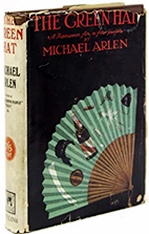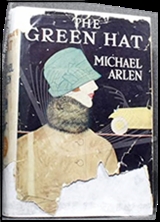Thu 10 Feb 2022

MICHAEL ARLEN – The Green Hat. Collins, hardcover, 1924. George H. Doran, US, hardcover, 1924. Reprinted numerous times.
Few remember today, but in its time The Green Hat was ranked as a masterpiece, a best-seller, and — not incidentally — a steamy shocker that smoothed the road for The Great Gatsby (1925) and The Sun Also Rises (’27) where the antics of Daisy Buchanan and Lady Brett Ashley paled in comparison with the exploits of Hat’s Iris Storm.
But what is so dull as last year’s scandal? The Green Hat has faded into obscurity, and that’s kind of a shame because it offers some dark, saturnine prose, and a twisty, half-hidden story line that seems driven by passion, but….
But that would be telling. Let me just say that it starts very fittingly on a squalid street in London in the dead of night, when a mysterious woman in an expensive car calls on the narrator for help. It turns out she is the notoriously promiscuous Iris Storm, and she needs the author to let her in the apartment building he shares with her drunken brother. And to help her up the dark and treacherous stairway. And see if the brother is in any shape to receive company….

He isn’t, and the two of them talk into the small hours of a new day, forging some sort of relationship, not love, but a mutual regard — this despite the fact that Iris has a reputation that would have shamed Lord Byron.
The plot, such as it is, develops slowly, with many digressions along the way, but The Green Hat isn’t about Plot; it’s about Mood, and this one is like Huysman’s La Bas set to the beat of the Jazz Age and turned in upon itself.
I mentioned Gatsby above, and I have to say that lovers of that novel (I’m one) may find Hat uncomfortably similar, even down to the scene where the lovers confront the forces of Convention, and one of them pushes too hard…
But again, that would be telling. I’ll just note for the record that Fitzgerald submitted The Great Gatsby to his publisher in 1924, the year The Green Hat swept the book stalls, and was urged to re-write it. And I’ll add that if Fitzgerald “borrowed†from Arlen, he also improved what he took. Hat ends on a note of high melodrama that was an octave too high for my taste, but that doesn’t spoil the unique atmosphere of the work.
And yes, this was the same Michael Arlen who created that mainstay of RKO’s B unit, The Falcon!
February 10th, 2022 at 10:08 pm
Young Ian Fleming was so taken with Arlen one of his first short stories was written in the Arlen style.
Storm’s son went on to write a bestselling book about his family’s Armenian heritage.
In this case nothing dates as quickly as yesterday’s “smart” novel.
February 10th, 2022 at 10:20 pm
I wasn’t especially interested in The Green Hat, but I was with Nancy Cunard, the inspiration for Iris Storm. The further I went into her life, the more horrifying, especially Nancy’s last years. Check it out or rather check her out
February 10th, 2022 at 10:51 pm
A starting point:
https://en.wikipedia.org/wiki/Nancy_Cunard
February 11th, 2022 at 10:42 am
The 1928 silent film version is “A Woman of Affairs”. It sounds good on paper. It stars Greta Garbo, is directed by talented Clarence Brown.
But actually it is merely Depressing. And how. These few friends have more problems than the entire town of Peyton Place.
February 11th, 2022 at 3:49 pm
There was also a stage adaptation, in which Iris was played by a young Tallulah Bankhead.